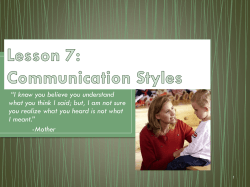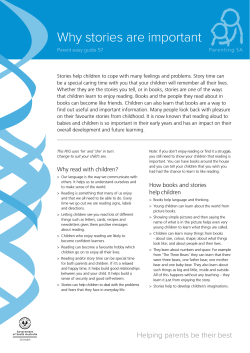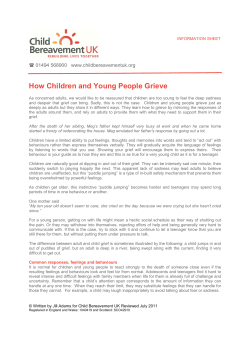
voices of pioneers A Larry Brendtro
voices of pioneers Al Trieschman on Tough but S a d Children Larry Brendtro A bert E. Trieschman ( 1 93 1 - 1 984), Founder and Executive Director of the Walker Home and School in Needham, MA, achieved international recognition for his work with troubled children. I was privileged to share a conference platform with AI on the occasion of one of his last addresses. He told the profes sionals in the audience that he was prepared to reveal the most significant observation that one could ever make about troubled children. The audience strained to hear the discovery, and AI de clared with a characteristic radiance: 'The most important ob servation you will ever make is when you discover that you have become a glimmer in the eyes of a child, and the child has be come a glimmer in your eyes as well !" Albert E. Trieschman 1 931 - 1 984 Al brought the sophistication of his Harvard Ph.D. in psy chology to the front-line problems of working with troubled children in their moments of rage and despair. His classic 1 969 publication, The Other Twenty-Three Hours, extends treatment beyond the therapy session to the total living learning ecology of the child. Before founding the Walker program, Al served as a staff psychologist at the Judge Baker Guidance Center and the Children' s Hospital Medical Center, Boston, Massachusetts . He was also a faculty mem ber in psychiatry at the Harvard Medical School and past president of the American Association of Children' s Residential Centers . Throughout his distinguished career, Al Trieschman never lost touch with what it means to be a child, nor with the trou bled and joyous feelings that are part of growing up. His own career was shaped by his mentor, Dr. Robert White of Harvard, who pioneered in theories of competence motiva tion. The following excerpts from Children A way From Home (Whittaker and Trieschman, 1 972) show Trieschman' s focus on the potential for competence and normalcy in the most troubled of children. 54 .. JEB-P "I am going to raise hell if I can 't find my model airplane. " C hildren who hate often are :�il.dren who hav� s.uffered so Another teaching device i s the use that staff make of thier cned out," unwlllmg or un own affective state s . When we feel disappointment, experience able to deal with any more sadnes s . The child' s sadnes s loss , and then model and share this emotional experience with many losses that they are and sense of l o s s are easily overlooked in our eagerness t o "get children, our example is subj ect to imitation. When we ourselves things under control . " can ventilate, keep working, use a little humor, the children can We are inclined to help them deal with anger, when perhaps we should focus on developing their com use the opportunity to be observant pupils. When we exploit small segments of reality to teach about petence to deal with loss. In our work with hyperaggressive children at Walker, w e dealing with sadness, we make use of innumerable opportunities have b e e n forced t o think about ways we could help children that occur daily such as the end of a pleasant game or the loss of learn to deal with loss and sadne s s , while we were coping with a favorite coulselor until tomorrow . At these times , it i s al so their acting out behavior. We find opportunities for teaching possible to use the technique of encouraging partial replace about sadness in the circumstances of daily living . Hopefully, ments for losses, such as reattachments to a new friend, or even our notions help the adults who encounter the child in the 23 transitory withdrawal. The child who does not know how to use hours outside therapy to be constructive agents of change in the solitude has a tremendous investment in warding off sadnes s by child ' s life . being constantly in the thick of things . S ome events have the clear ring o f loss-the home - sickness of new arrivals, the discharge of a child' s close friend, the death of a pet, the leaving of a favorite staff member- these "big This youngster might need to learn to develop the capacity to be alone and find that there i s a "constancy of people" who still accept him on return. It is important to note that we have not focussed on patholog league" events are rarely overlooked. S ome of the small lossses ical depres sion or distortions of the mourning proces s . that present worthwhile opportunities to help children develop these occur - and with frequency among disturbed children loss-bearing include broken or missing toys , no mail , losing a but we emphasize that learning to master loss is a human neces game, difficulty in mastering a skill. Teaching loss-bearing ca pacities at such times not only helps extend the emotional com sity, not j ust a "cure" to mental illne s s . Indeed, Our techniques help adults make an alliance with that part of the child struggling p e t e n c e of c h i l d r e n , b u t a l s o h e l p s keep b e h a v i o r w i th i n against his difficulties . This i s an alliance for teaching emotional reasonable limits . competence. To encourage a child to ventilate his feelings of sadness di rectly i s a useful teaching device . One might say to a child, "one of the things you can do first when you ' re feeling s ad like this is to cry . It' s all right. be able to stop . " The tears won ' t last forever; you ' ll One might suggest a private place to an older child too embarrassed to cry openly in the company of peers . An equally useful device is to help a child develop the capac ity to repres s or suppre s s sadne s s , to "forget about it." There are times that for the benefit of helping a child repair his life and proceed to grow , crying must stop . If the child is to learn skills and participate in scholastic affairs, the task of "putting the sad ness in the back of his mind" has to be given to the child . T h e language of feelings can be used to teach a n d remind children o f pos sible ways of behaving when " s a d . " One can teach a child that when he hames feelings and can talk about them, he c an kno w them himself and then tell others how he feels . To enhance the awarenes s of feelings , the techniques of roleplaying , improvisation, and acting can be used. The legacy of A l Trieschman continues in his writings, in the work of the Walker School, and in the activities of the A lbert E. Trieschman Center, a national resource center providing advo cacy, research, and training to help practitione rs find better ways of working with high- risk children, youth, and their fami lies. Fo r fu rth e r i nfo rm a t i o n , c o n ta c t D r. Floyd A lw o n , D i re c t o r, t h e Tri e s c h m a n Ce n t e r, 1 9 68 C e n t r a l A v e n u e , Needham, MA 021 92, phone (61 7) 449-0626. Resources: The foregoing was condensed from Albert Trieschman and Bernard Levine ( 1 972), "Helping Children Learn to Deal with S adness" in Whittaker, J . and Trieschman, A. (Eds . ) Children Away from Home: A S o u r c e b o o k of R e s i d e n t i a l T r e a t m e n t . C h i c a g o : A l d i n e Publishing Company . Trieschman, A . , Whittaker, J . , and B rendtro, L. ( 1 969). The Other 23 Hours: Child Care Work with Emotionally Disturbed Children in a Therapeutic Milieu. New York: Aldine du Gruyter. This book is also available in German, Danish, Dutch, and Japanese editions . SUMMER 1 993 . 55
© Copyright 2025





















